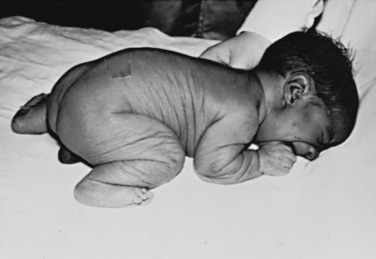Cutis Laxa
Clinical Features, Genes and Therapeutics
Cutis Laxa is a group of inherited connective-tissue disorders characterized by excess skin that hangs loosely in folds, about the face and body, often giving affected individuals a prematurely aged appearance.
The Latin cutis laxa means loose skin. The loose skin may be thickened and dark. If it affects the skin around the eyes symptoms such as burning, redness, light sensitivity and loss of eyebrows and lashes may occur.

The skin is inelastic and, if pulled, does not spring back upon release. It is not fragile, and the joints are not loose and hypermobile.
While it is usually evident at birth, there have been reports of a few late-onset cases. There is also an acquired form that doesn’t manifest until puberty or later, which often follows an inflammatory illness and appears to have an autoimmune basis.
Affected individuals are said to have hound dog faces and are often described as appearing mournful. They have a beaked nose and long upper lip.
Frequently, other abnormalities are associated with cutis laxa, and cardiorespiratory are associated with cutis laxa, and cardiorespiratory complications and inguinal hernias may also be seen.
These disorders are very rare, with approximately 40 cases reported. Four types are clinically recognized.
- Type I
In this relatively benign form, the laxity of skin is the only abnormality exhibited. Though the excess of skin is mildest in this form, adolescent children may appear older than their unaffected parents. It is inherited as an autosomal dominant trait Opens in new window.
This form can be caused by mutations in the elastin gene. (Mutations in the gene encoding fibulin-5 can cause either autosomal dominant or autosomal recessive cutis laxa.)
- Type II
Type II, being the most common form, is severe or lethal. Affected individuals also have emphysema, which interferes with their ability to breathe, as well as other cardiopulmonary problems.
There may be mild malformations of the gastrointestinal and genitourinary tracts. Infants typically have hoarse, harsh, deep and resonant voices caused by the laxity of vocal cords. This form is inherited as an autosomal recessive trait Opens in new window. Death usually occurs early in life due to complications from emphysema Opens in new window.
- Type III
In addition to loose skin, individuals plagued with this form exhibit retarded physical development, with height typically below the 10th percentile for age.
Mild mental retardation Opens in new window is also common. Joint laxity and congenital hip dislocation are seen. It is thought to be inherited as an autosomal recessive trait.
- Type IV
Type IV cutis laxa is the only form in which the basic defect causing the disorder has been identified. A deficiency of lysyl oxidase interferes with the normal activity of collagen, an important component in the formation of skin.
This form is inherited as an X-linked recessive trait Opens in new window. It is caused by mutation in the Cu(2+)-transporting ATPase, alpha polypeptide gene, the same one that causes Menkes syndrome.
Type IV is the same entity as Ehlers-Danlos syndrome, Type IX. It is also known as occipital horn syndrome, because of the nubby protuberances at the back of the skull (occiput).
These individuals have lax skin, hypermobile joints and other bony abnormalities. It appears as a result of a fundamental abnormality of copper metabolism, copper being necessary to lysyl oxidase activity.
See also:
- Adapted from The Encyclopedia of Genetic Disorders and Birth Defects By James Wynbrandt, Mark D. Ludman

